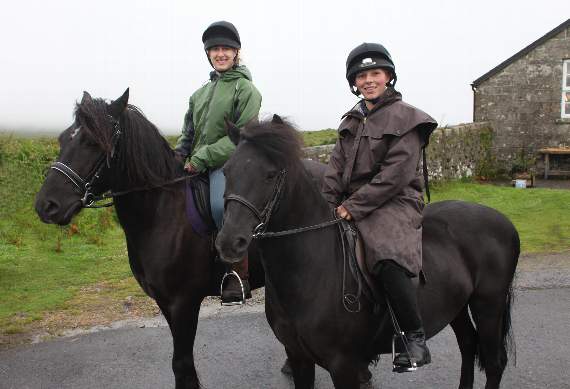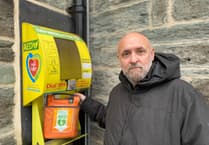A CHANCE to learn about the history of the creature synonymous with our moors, the Dartmoor pony, is open to all who visit a new exhibition near Postbridge — from an early Palaeolithic cave painting depiction to today’s efforts to preserve the breed.
In a combined effort led by the Friends of the Dartmoor Hill Pony, the exhibition has been created in memory of the late Freda Wilkinson, a local pony keeper, whose extensive knowledge of the history of the pony was passed on to Friends’ founder Charlotte Faulkner. Charlotte wanted to let other people know about the interesting history of the pony, and the Dartmoor hill pony in particular, and so set about creating the exhibition, which was officially opened last week.
Charlotte said: ‘We put in a bid to the Sustainable Development Fund to do an exhibition on ponies. Freda Wilkinson started telling me the whole story of the pony before she died and I wanted to let other people know it too.
‘We had to go to London to check some of the facts to make sure that we were accurate in what we were saying.’
The historic timeline begins with photographs of cave paintings found in France and Spain of ponies. It states: ‘It is thought that ponies were introduced to Britain from the European continent by early man. The wild Celtic pony appears in Palaeolithic cave paintings in France and Spain — some include spotted and partly coloured ones. Stone Age man would have hunted ponies for food.’
It was in the Bronze Age that humans began to farm on Dartmoor. Following an archaeological dig on the moor, hoof prints were uncovered, providing evidence that ponies were farmed together with cows and sheep from as early as 1350BC.
The first written record of ponies on Dartmoor was back in 1012 when the Bishop of Crediton bequeathed the wild horses of Ashburton.
The exhibition also focuses on the ponies more locally with an extract from Dartmoor’s court records from 1573 to 1588 at a time when owners had to pay to get their ponies back if they wandered from the common onto the Royal Forest (now known as Dartmoor). The extract is written in Latin but tells of John Bonamy of Chagford going to Lydford court to claim back his black and white hill pony mare, which he had to pay three pennies to retrieve.
The actual translation says: ‘Lidford East: Court of the manor and forest held there on 4 Jul Eliz (1588). Proof of stray 3d: At this court there came John Bonamy the elder of Chagford and in due manner he proved that a certain mare of the colour pied, which issued as a stray upon the aforesaid east quarter of the forest of Dartmore, is his own goods.’
In the 19th century, ponies became very useful workers, because of their strength and agility, being used as pack ponies, postmen’s transport, moving granite rocks and pulling trucks on the granite railway at Haytor.
The timeline states: ‘It is rumoured that smugglers used hill ponies to carry their booty. They bred the white out of their fur so that they could not be seen in the dark.’
Throughout the 20th century, ponies were sold at annual pony fairs in Tavistock, Princetown and Chagford. They went for shillings when a weekly wage was 30 shillings. Before and during the Second World War, 90% of ponies sold for a good price as food.
Unfortunately, in 1999 the live exports of animals came to an end and as a result the European meat trade ended at the same time the Government introduced agri-environment schemes on the commons of Dartmoor meaning the number of grazing animals were limited to allow more diverse vegetation to grow.
‘Male colt foals left unsold at market were taken back to the farm, shot and buried. Female foals were selling for just two guineas. Only coloured ponies sold — as pretty riding ponies or hides. A sale in 2006 was the last at which all ponies taken were sold,’ one of the boards states.
Due to this decline in the pony market and farmers allowed to keep less ponies grazing on the moor, a problem arose with too many ponies that ended up having to be shot to control numbers.
In 2000 Charlotte set up Friends of the Dartmoor Hill Pony to help find a way to ensure the indigenous hill ponies of Dartmoor have a future.
‘In this modern era of the hill pony, when there is very little market for them, but they have to be taken off the moor in order to comply to agreed numbers, we have a problem; mares produce foals when they live with stallions.
‘Should we try to remove all stallions from the moor? Or will we create a bigger problem than the one we are trying to solve? Will the impact on herd structure, pony well-being and grazing patterns be negative? Can we really ensure all stallions are removed from an area the size and terrain of Dartmoor?’
The Friends’ group introduced a ‘pony on the pill’ contraception scheme for mares a few years ago as a way to control breeding without the need to remove stallions and disrupt the natural herd structure.
They also set up ‘Wild to Wonderful’ to re-home foals and ponies from the Dartmoor hill pony herds that cannot be returned to the moor. They work with the foals to take them from wild to handleable so at the age of three or four they can be sold for riding or driving, thus making them more marketable.
At the official opening of the exhibition, the Friends had brought three foals who were around a year old to demonstrate what they were like when they were wild.
Carolyn Owen, who was showing the foals, said: ‘Our aim is to tame them to the point where they are head collar trained and you can lead them. Then they are an asset — they have a CV to go out in the world with so someone else can take them on and manage them. We get them to the point where we can show them to the public and offer them as competition ponies or a child’s riding pony. It’s about giving them another chance.’
The Friends have so far re-homed more than 5,000 ponies as grazing, riding, driving or companion ponies. They also have a display team of children and youngsters of all ages and abilities which choreographs and performs a complex routine of wheels, reels, cross-overs and tricks at shows and events across the South West to show how the hill pony can be a great riding pony.
The exhibition will be open everyday from 10.30am to 5pm until October, at Powder Mills Pottery, near Postbridge. Interested people can have a tour of the moor after the exhibition by car, bike or even horseback, to better understand what has been learned at the exhibition.





Comments
This article has no comments yet. Be the first to leave a comment.